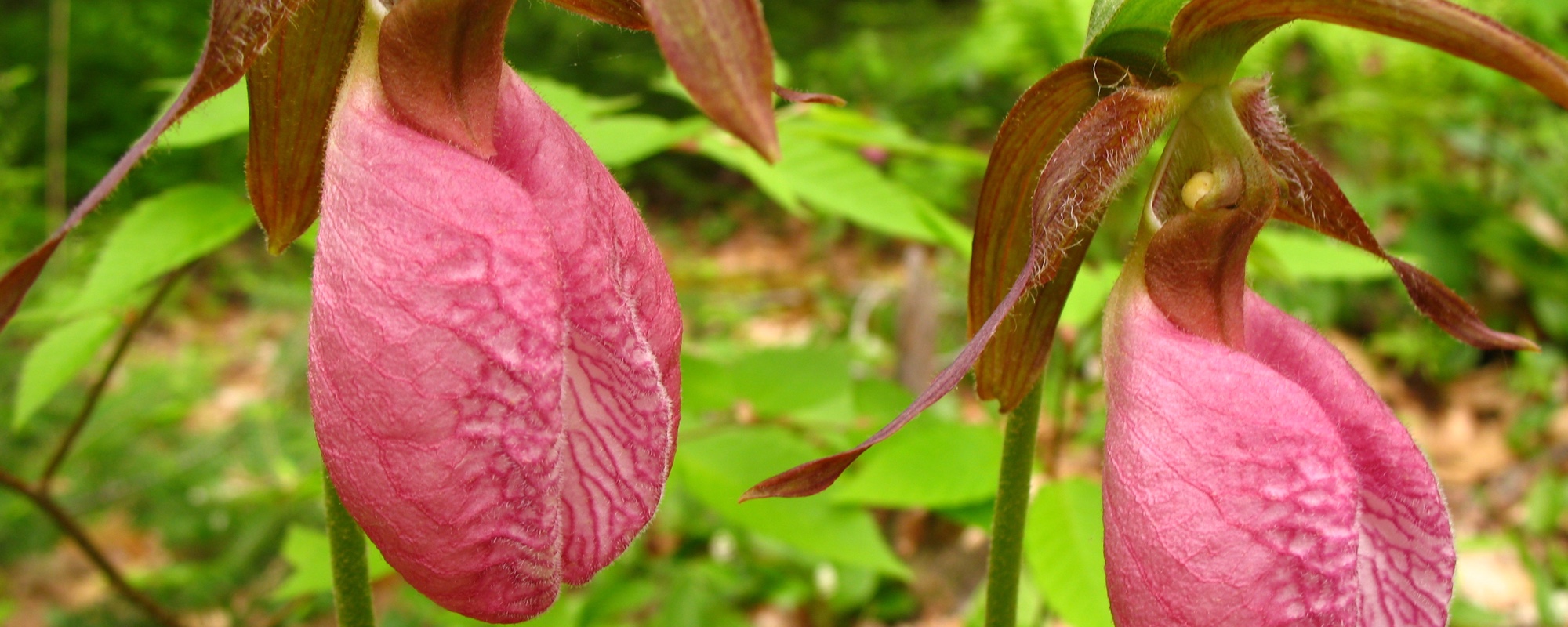One of our showiest native terrestrial orchids is the Pink Lady Slipper, Cypripedium acaule. The genus name comes from Latin meaning ‘Venus’s slipper’. Other common names include Pink Moccasin flower, and Whip-poor-will’s-shoe. It is found over a large area of Canada and the Eastern half of the United States from Newfoundland and Nova Scotia south to Georgia, west to Alabama and Tennessee and north to Minnesota.
The plant has two basal leaves with the veins running parallel to the leaf margin, which is typical of monocot venation. The flower appears in late spring on a leafless stalk 6 to 15 inches tall. The sepals and side petals are greenish-brown. The hollow pouch-like lip is about two inches long and pink. I noticed their fragrance for the first time this spring. I am not sure if it was the time of day, temperature or just the large number of blooms that caused them to perfume the air.
Pink Lady Slippers are listed among the 103 plants protected in Georgia by the provisions of the Georgia Wildflower Preservation Act of 1973. While they are not rare they have a history of being poached from the wild, a deplorable practice as they rarely survive transplanting. Lady Slippers form a symbiotic relationship with a soil fungus that is crucial to their survival. Without the fungus they dwindle away in 3 to 5 years. Information from the Department of Botany at the University of Wisconsin further stated that the fungus is necessary for their seeds to germinate. Stating that Lady Slipper seeds lack the food supply found in most seeds and need the thread-like mycorrhizal fungi to break open the seed and attach to it.
As mentioned earlier the Lady Slippers are not rare and can be found on plant rescues. But because of the difficulty in relocating them you should never dig them unless they are in danger of being bulldozed. I have rescued plants that have survived for 10 to 12 years. For best results the area needs to be similar to where they are found, usually pine, oak forests with deep pine needle litter. When digging them try to get a large amount of the duff in which they are growing in order to get the needed fungus. While they grow in dry woods keep them watered until established.
At a GMGA conference last year, Jim Allison spoke on rare and endangered plants. He really impressed on me the need to have these plants on public lands where they can be protected. Those planted in private gardens may not be appreciated or cared for by the next owner. So when one of my gardening friends found a very large colony of Pink Lady Slippers in Paulding County that are threatened by construction I began trying to relocate large numbers of them to public parks and gardens. So far we have dug large numbers and given plants to Pickett’s Mill Battlefield Park, ABG’s Smithgall Arboretum, Smith-Gilbert Arboretum, McEachern HS Nature Center, Kemp Elementary Nature Trail and the Chattahoochee Nature Center. Hopefully they will thrive in their new locations and be enjoyed by visitors for many years to come.


I have 3 groups of Pink Lady Slippers in my back yard. When I bought the property in 1997 It had 1 plant. I have carefully watered in drought years and put homemade compost around it each year. It has rewarded me with some additional plants about 30 feet away from the original. I enjoyed your article and learned from it. Thank for this well written article. I am also a Master Gardener in Forsyth. Look forward to meeting some of the Cobb MG at your tour and plant sale this year 2015.